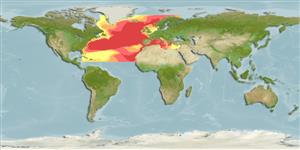>
Myctophiformes (Lanternfishes) >
Myctophidae (Lanternfishes) > Lampanyctinae
Etymology: Lampanyctus: Greek, lampas, -ados = torch + Greek, nykte = night (Ref. 45335).
More on author: Risso.
Environment: milieu / climate zone / depth range / distribution range
Ecología
marino batipelágico; oceanodromo (Ref. 51243); rango de profundidad 0 - 1200 m (Ref. 56504), usually 275 - 1000 m (Ref. 117245). Deep-water; 72°N - 16°N, 82°W - 36°E
Eastern Atlantic: strays as far north as Dohrn Bank (off East Greenland) and off northwest Iceland, from British Isles to Mauritanian Upwelling Region including the Mediterranean (Ref. 4479). Western Atlantic: as shallow as 46 m in Ungava Bay, Canada, in slope water region (Ref. 5951).
Tamaño / Peso / Age
Maturity: Lm ? range ? - ? cm
Max length : 30.0 cm SL macho / no sexado; (Ref. 4479)
Radios blandos dorsales (total) : 13 - 14; Radios blandos anales: 16 - 18. Distinguished from other species of Lampanyctus by the pattern of its photophores and by its short pectoral fins located just behind gill opening (Ref. 5571). Photophores along ventral post-anal region (AO): 6 (7) + 8 (7-9) = 14 (13-16) (Ref. 4775).
High-oceanic, between 700-1,000 m during the day (with juveniles in the upper 200 m) and 45-250 m and 4000-1,000 m at night (Ref. 4479). Depth range from 318-1192 m in the eastern Ionian Sea (Ref. 56504). Epipelagic to bathypelagic, feeds on zooplankton (Ref. 58426). Catches of lanternfishes off the west coast of South Africa: 1,134-42,560 mt (Ref. 5571). Minimum depth from Ref. 58018.
Life cycle and mating behavior
Madurez | Reproducción | Puesta | Huevos | Fecundidad | Larva
Apparently spawns in deepwater.
Bauchot, M.-L., 1987. Poissons osseux. p. 891-1421. In W. Fischer, M.L. Bauchot and M. Schneider (eds.) Fiches FAO d'identification pour les besoins de la pêche. (rev. 1). Méditerranée et mer Noire. Zone de pêche 37. Vol. II. Commission des Communautés Européennes and FAO, Rome. (Ref. 3397)
IUCN Red List Status (Ref. 130435: Version 2024-1)
Threat to humans
Harmless
Human uses
Pesquerías: de interés potencial
Herramientas
Special reports
Download XML
Fuentes de Internet
Estimates based on models
Preferred temperature (Ref.
123201): 3.4 - 14.6, mean 7.9 °C (based on 594 cells).
Phylogenetic diversity index (Ref.
82804): PD
50 = 0.5000 [Uniqueness, from 0.5 = low to 2.0 = high].
Bayesian length-weight: a=0.00417 (0.00327 - 0.00532), b=3.17 (3.11 - 3.23), in cm total length, based on LWR estimates for this species (Ref.
93245).
Nivel trófico (Ref.
69278): 3.2 ±0.39 se; based on food items.
Resiliencia (Ref.
120179): Bajo, población duplicada en un tiempo mínimo de 4.5-14 años (Preliminary K or Fecundity.).
Fishing Vulnerability (Ref.
59153): Low to moderate vulnerability (27 of 100).
Nutrients (Ref.
124155): Calcium = 46.8 [13.0, 130.5] mg/100g; Iron = 0.409 [0.153, 1.286] mg/100g; Protein = 16.6 [14.8, 18.4] %; Omega3 = 0.258 [0.088, 0.738] g/100g; Selenium = 17.5 [5.5, 56.1] μg/100g; VitaminA = 53.6 [6.7, 453.7] μg/100g; Zinc = 0.651 [0.330, 1.380] mg/100g (wet weight);
